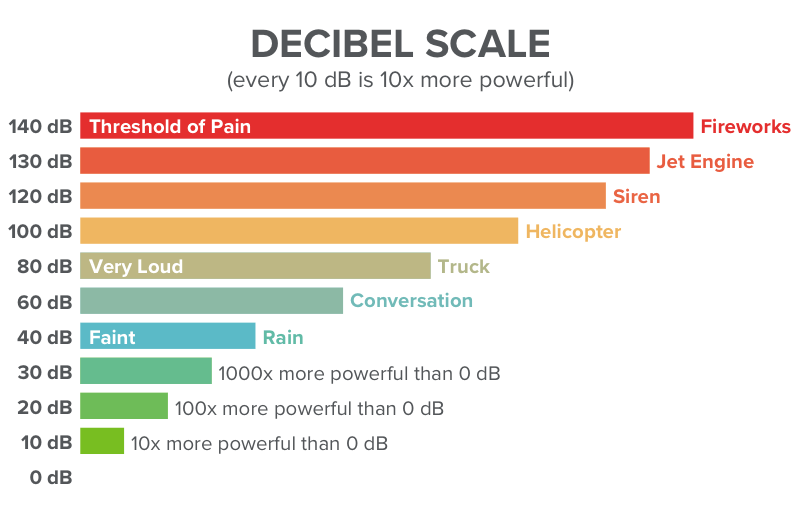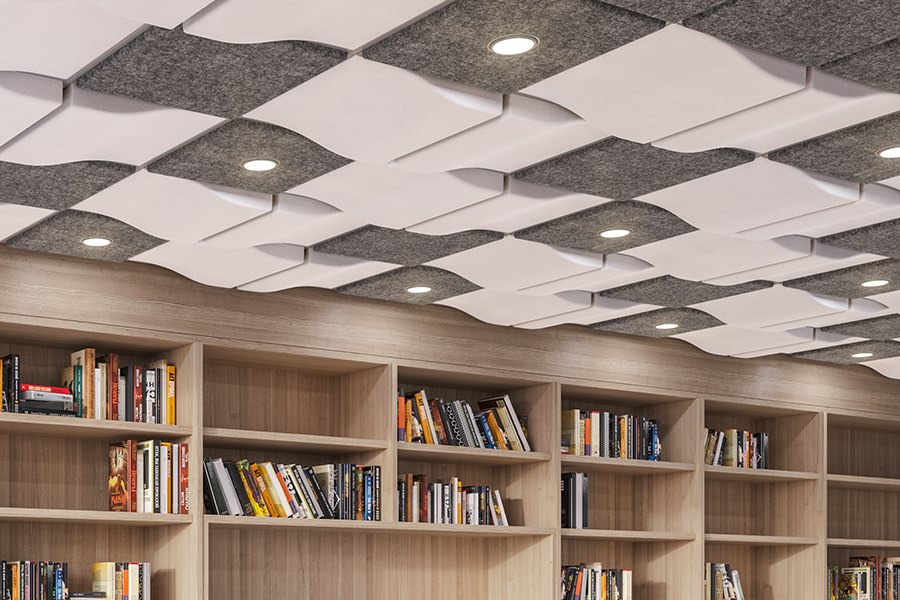Genesis Trend Watch / Q2 2023
The Quiet Revolution
When it comes to designing commercial environments, the impact of acoustics is often underestimated.
We all know that loud noise can be annoying and distracting—even painful. But the non-auditory effects of noise exposure are as widespread as they are unrecognized. The good news? Today, you can find sound control solutions that add style while they suppress sound. And they don’t have to break the bank.
Creative Solutions for Acoustic Control
In this installment, you’ll discover:
1
The effects of excess noise
2
Key terms and sound control techniques
3
Popular acoustical solutions
4
How to choose acoustical solutions
The surprising impact of acoustics
Why do acoustics matter? Noise puts the entire nervous system into a state of acute alertness. In this state, the body is flooded with hormones such as adrenaline and cortisol, causing increased heart rate, breathing and muscle tension. That’s ideal for a brief fight or flight situation—but not ongoing exposure.
Let’s look at the effects of excess noise in specific environments.
Unwanted Sound at Work
Poor acoustics in the office or workplace can have a negative effect on focus, productivity, and morale. In fact, noise accounts for 71% of all workplace distractions1 and excessive noise has been linked to hearing loss, fatigue, and high blood pressure.275% of employees feel that better acoustics are important to an effective workplace.
Acoustics in Education
Imagine trying to learn to read amid highway traffic. The average noise level in a classroom is 72 decibels3, which is comparable to highway traffic at a distance of 50 feet. Continuous disruptive noise impairs student performance and adds to teacher stress and fatigue.Good acoustics in the classroom provide a healthier environment for students and instructors and help improve educational success.
Avoiding Noisy Venues
In hospitality, acoustics shape the atmosphere. In fact, 91% of people said they would not return to a venue where noise levels are too high.- Noise disturbance is the #1 guest complaint at hotels 4
- 79% of people have experienced difficulty having a conversation while at a restaurant 5
Better acoustics encourage guests to stay longer, spend more per visit, and be more likely to return.
Excess noise can impact our ability to learn, work and relax.
Before we look at ways to manage unwanted sound, let's review a few important terms and techniques related to sound control.
Acoustics 101
A few key terms to understand:
Noise Reduction Coefficient (NRC)
The ability of a material to reduce reverberant sound in a room. Measured on a scale of 0 (absorbs no sound) to 1 (absorbs all sound).
NRC Ratings: 0.70=Good, 0.80=Better, 0.90=Best
Sound Transmission Class (STC)
A rating that indicates a product’s effectiveness in reducing airborne sound transmission. The higher the STC, the better.
STC Ratings: 25-30 Poor, 30-35 Fair, 35-40 Good, 40-50 Very Good, 50-60 Excellent
DECIBELS (dB)
A measurement of how loud or soft a sound level is based on the intensity of its sound energy. Important: The dB scale is not linear, so a small numerical increase can indicate a noticeable change in the sound level.
The ABCDs of Acoustic Control
Absorb
Sound absorption materials reduce the reverberant sound in a room, lowering the effective sound level.
Block
A physical barrier between the source and listener helps to stop sound energy from traveling from one area to another.
Cover
A masking sound such as white noise can help neutralize conversation and ambient noise for more privacy and focus.
Diffuse
Scattering or spreading out the sound energy within a space improves speech intelligibility and clarity.

Popular Acoustical Solutions
Here are some of the simplest and most popular acoustical treatments for light commercial applications, including offices, schools and hospitality venues. New materials are creating exciting color, style and design possibilities.

Acoustic Wall Panels
These decorative panels are attached to existing walls to help absorb sound and reduce reverberation.

Acoustic Ceiling Tiles
This cost-effective, easy-to-install solution “drops in” to a suspended ceiling grid to reduce unwanted noise.

Workplace Dividers
Modular cubicle partitions and privacy screens block and absorb sound while visually separating workspaces.

Ceiling Baffles
Suspended from high ceilings, sound baffles help reduce ambient echo and reverberation in large open spaces.

Flooring
Acoustic flooring materials and techniques help mitigate impact noise from walking and daily activities.

Furniture & Accessories
From seating and storage to cord management solutions, look for options made of acoustical materials.
Choosing Acoustic Materials
Sound control solutions come in a wide variety of materials from wood to fiberglass, fabric and foam. Traditional acoustic ceiling tiles made of mineral fiber and wastepaper pulp are inexpensive but prone to breaking and staining. Designer acoustical treatments can be artistic but expensive. Recently, another alternative has been gaining popularity for its many physical, aesthetic and acoustical advantages: eco-friendly PET.
PET: Eco-Friendly Acoustic Control
Despite its complicated name, Polyethylene Terephthalate, or PET, is an incredibly eco-friendly and versatile material. Here are a few of the reasons why designers, architects and contractors are turning to innovative acoustical solutions made of PET.
Superior Sound Absorption
PET acoustic panels can outperform traditional acoustic ceiling tiles with sound absorption performance of 0.75 to 1.00 NRC or more, depending on the manufacturer. (Genesis Products ceiling tiles can reach an NRC of 1.00 in some situations.)
Design Potential
Decorative acoustic panels like Qwel™ designer acoustic tiles add style while controlling sound. Lightweight, affordable and easy to use, they drop into a standard ceiling grid to give any space an instant upgrade.
Custom Solutions
PET can be custom fabricated in many colors, thicknesses, densities and shapes. An experienced PET fabricator like Genesis can devise innovative solutions that suppress excess sound and help you to meet specific acoustical requirements.
Sustainability
PET is made of up to 50% recycled material (like discarded water bottles) and is 100% recyclable, helping to keep plastic waste out of the landfill.
Air Quality
Unlike some fiberglass acoustic panels, PET acoustic panels have no formaldehyde or phenolic resins. PET is nontoxic and odorless with no leaching or off-gassing and can achieve Class A ratings for fire and smoke.
Durability
PET tiles are washable and water-resistant, can tolerate high humidity, and also resist fading and impact, to help keep any space looking clean, inviting and well-maintained.
Domestic PET Design and Fabrication – and More
While the majority of PET comes from overseas, Genesis offers domestic supply, design and manufacturing capabilities. Working with a domestic provider can help to streamline timing and cost while offering better responsiveness and quality control.
And because of our in-house design, engineering and materials expertise in laminated panels, wood component and custom molded solutions Genesis can work with OEMs, architects and developers to streamline solutions for office, education, hospitality and healthcare projects.
“Consumers have become more aware of increased noise levels in their everyday lives. One of our goals is to improve the sound quality of spaces for work, relaxation, learning, or healing…to provide quiet spaces to enjoy life.”
– Jennifer Shaw, Product Development Engineer, Genesis Products
Looking for customized sound control for office, education and hospitality environments?
- 2018 Workplace Distraction Report
- Noise-Pollution-Human-Health-A-Review.pdf (researchgate.net)
- Classroom Noise Pollution And Its Negative Effects | Knauf Insulation (knaufnorthamerica.com)
- Steps For Hotels To Take That Will Minimize Noise Complaints (alertify.io)
- Quiet Stay Certification — Quiet Parks International
- Great food, but please do something about the noise’ – the battle for quieter restaurants | Restaurants | The Guardian
Stay ahead of the trends
Sign up for Trend Watch Updates to keep up with emerging trends, hot products and exciting new technologies. (We’ll never share or sell your email.)